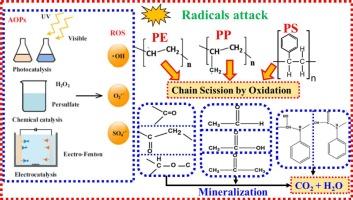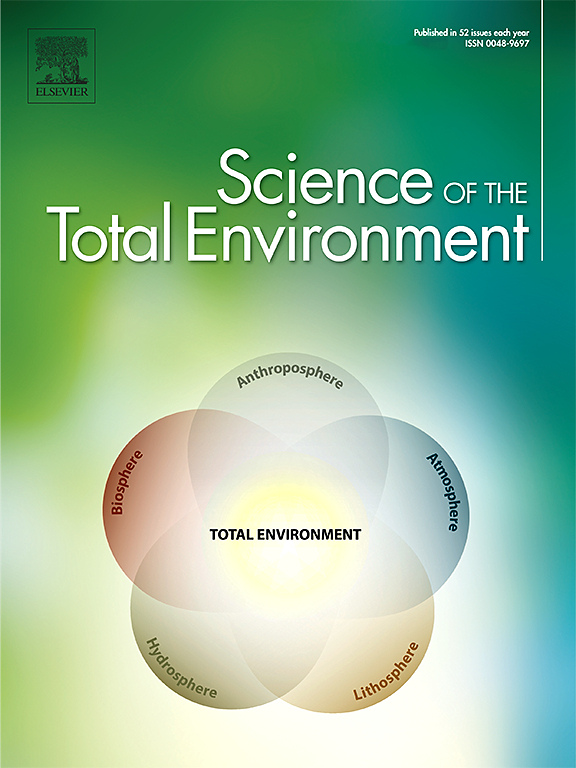Recent advances in mechanistic insights into microplastics mitigation strategies via emerging advanced oxidation processes: Legislation, challenges, and future direction
IF 8
1区 环境科学与生态学
Q1 ENVIRONMENTAL SCIENCES
引用次数: 0
Abstract
Microplastics (MPs) pollution has emerged as a global environmental concern due to its detrimental impacts on ecosystems. Conventional wastewater/water treatment methods are inadequate for MPs removal due to their diminutive size ranging from micrometers to nanometers. Advanced oxidation processes (AOPs) have gained attention as a promising green strategy for the efficient and safe elimination of MPs from aqueous systems. In recent years, various AOPs, including direct photo-degradation, photocatalytic oxidation, electrochemical oxidation, sono-chemical oxidation, ozonation, as well as sulfate radicals-based AOPs (SR-AOPs), and the use of hybrid systems have all been extensively investigated for MP elimination. However, the molecular mechanisms of MP polymer chain scission by AOPs have not been thoroughly studied so far. In this review, we have attempted to provide a thorough overview of molecular mechanisms and highlighted recent advances in the degradation of commonly used MP by AOPs. The characteristics and limitations of each technique are thoroughly examined. Additionally, current policies and legislation on plastic pollution are discussed, emphasizing the need for regulatory frameworks to support effective MPs mitigation strategies. To advance the practical application of AOPs for MPs removal, future research direction should address the transition from controlled laboratory environments to complex field conditions, assess the sustainability of AOPs in terms of catalytic material design, selection of effective oxidants, power consumption, and operational costs. Given these challenges, recommendations for future research directions are proposed based on knowledge gaps in the reported literature. This review could offer a coherent summary of the molecular mechanisms involved in different MP elimination techniques, aiding in the advancement of more dependable AOPs technology with superior removal and degradation efficiency.

通过新兴的高级氧化工艺对微塑料减缓战略的机理认识的最新进展:立法、挑战和未来方向。
微塑料(MPs)污染因其对生态系统的有害影响而成为全球环境问题。由于微塑料的尺寸从微米到纳米不等,传统的废水/水处理方法不足以去除微塑料。高级氧化工艺(AOPs)作为一种高效、安全地消除水系统中 MPs 的绿色策略,已受到广泛关注。近年来,各种 AOPs,包括直接光降解、光催化氧化、电化学氧化、声化学氧化、臭氧氧化以及基于硫酸根的 AOPs(SR-AOPs)和混合系统的使用,都被广泛用于消除 MP。然而,迄今为止,人们尚未对 AOPs 消除 MP 聚合物链的分子机理进行深入研究。在本综述中,我们试图对分子机理进行全面概述,并重点介绍 AOPs 降解常用 MP 的最新进展。我们对每种技术的特点和局限性进行了深入研究。此外,还讨论了当前有关塑料污染的政策和立法,强调需要监管框架来支持有效的 MPs 减缓战略。为了推动 AOPs 在去除 MPs 方面的实际应用,未来的研究方向应解决从受控实验室环境到复杂现场条件的过渡问题,并从催化材料设计、有效氧化剂的选择、能耗和运营成本等方面评估 AOPs 的可持续性。鉴于这些挑战,根据已报告文献中的知识差距,提出了未来研究方向的建议。本综述可为不同的 MP 消除技术所涉及的分子机理提供一个连贯的总结,从而有助于开发出更可靠、去除和降解效率更高的 AOPs 技术。
本文章由计算机程序翻译,如有差异,请以英文原文为准。
求助全文
约1分钟内获得全文
求助全文
来源期刊

Science of the Total Environment
环境科学-环境科学
CiteScore
17.60
自引率
10.20%
发文量
8726
审稿时长
2.4 months
期刊介绍:
The Science of the Total Environment is an international journal dedicated to scientific research on the environment and its interaction with humanity. It covers a wide range of disciplines and seeks to publish innovative, hypothesis-driven, and impactful research that explores the entire environment, including the atmosphere, lithosphere, hydrosphere, biosphere, and anthroposphere.
The journal's updated Aims & Scope emphasizes the importance of interdisciplinary environmental research with broad impact. Priority is given to studies that advance fundamental understanding and explore the interconnectedness of multiple environmental spheres. Field studies are preferred, while laboratory experiments must demonstrate significant methodological advancements or mechanistic insights with direct relevance to the environment.
 求助内容:
求助内容: 应助结果提醒方式:
应助结果提醒方式:


